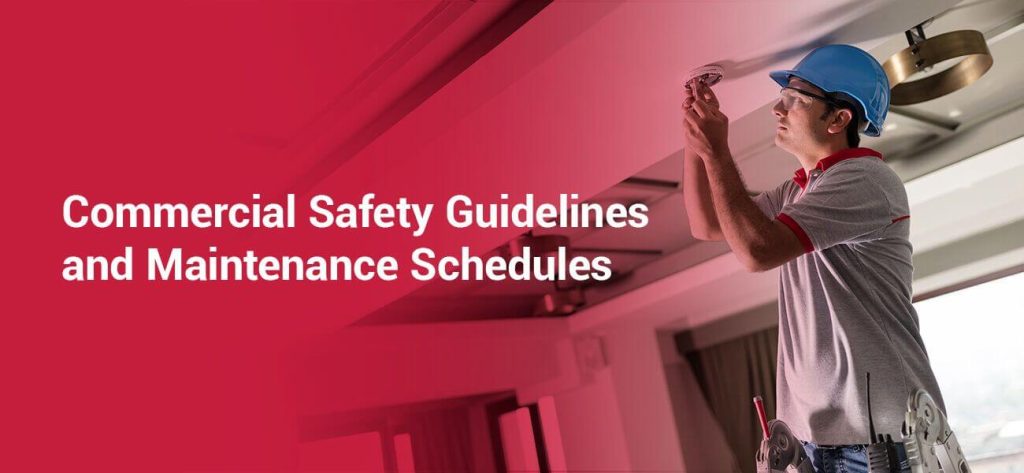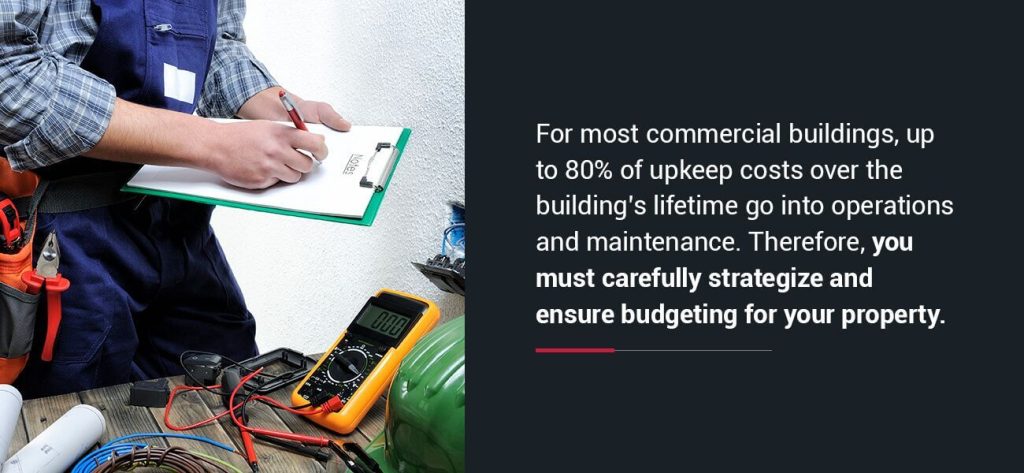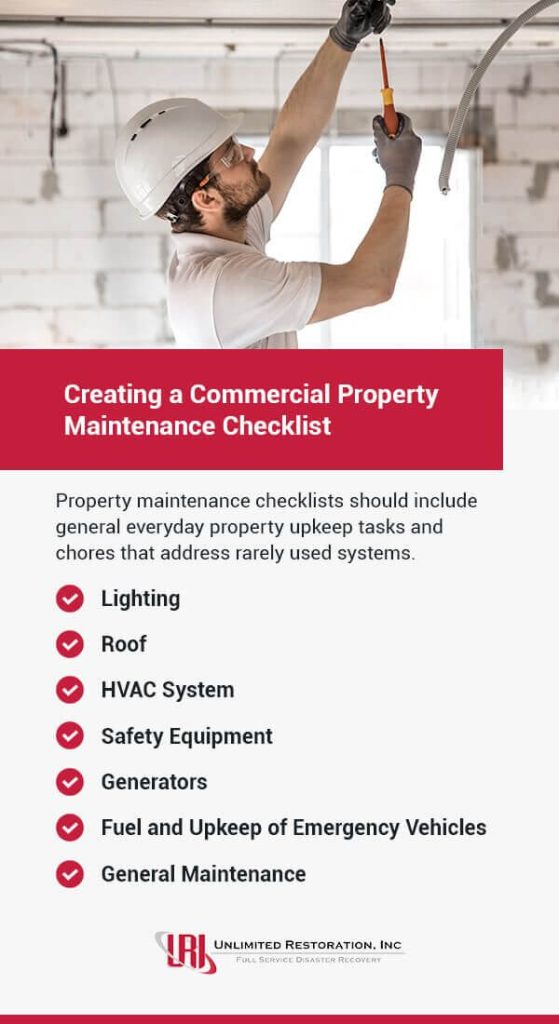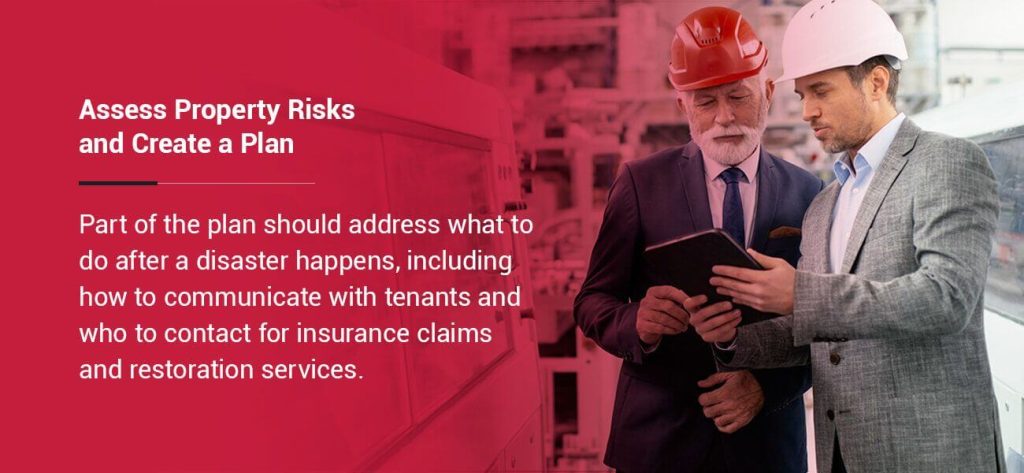
Managing properties requires making occasional repairs. Some repairs are necessary due to the natural aging of commercial properties. However, the need for other maintenance arises without warning in the aftermath of a natural disaster. Following a fire, flood, earthquake or storm, restoring the property falls to the site owners. This responsibility is also one of the types of property maintenance. Prepare your properties to bounce back quickly from catastrophic events with restoration help and planning.

Property owners generally hold responsibility for maintaining their buildings’ integrity. Repair and maintenance chores that ensure this may include the following:
Of course, specifications in the commercial property’s lease may require some tenants to take care of internal issues, especially those that are the tenant’s fault. For instance, an occupant may need to repair a plumbing problem caused by repeatedly pouring grease down the drain. However, if the problem happened due to an aging plumbing system, the owner may need to make the repairs.
Part of maintaining a commercial property includes creating an operation and maintenance plan for buildings. For most commercial buildings, up to 80% of upkeep costs over the building’s lifetime go into operations and maintenance. Therefore, you must carefully strategize and ensure budgeting for your property. Your system should include upkeep methods that keep existing structures in good condition and emergency response strategies. Specific aspects of an operations and maintenance plan may consist of the following:
Property owners have options for most tasks. They could choose to do the work themselves or assign some tasks to employees such as building managers or maintenance leaders. Each responsible party must have clear-cut expectations for what they must do during standard operations to maintain the property in everyday circumstances and after an emergency to restore the site.
Another option for delegating the responsibility of building maintenance is to let the tenants take care of all tasks. However, the lease agreement must carefully outline this to avoid legal problems. In many cases, it may be easier for property owners to do the work themselves, have a manager take it on or hire a third-party maintenance company.
A third-party maintenance group may conduct repairs and maintenance chores, but they cannot create an operation and maintenance plan or respond to emergencies.
Property owners must know how they want to approach site maintenance and who they want to assume responsibility for the job.
Part of property maintenance should include creating a response plan after a disaster. This plan reduces the time required to get help. Every maintenance staff member should know what to do and who to call immediately after severe property damage occurs. For instance, they need to know who is the first point of contact in the emergency chain of command. Having a restoration company’s contact information close at hand reduces the time needed to find a reputable source for post-disaster property repairs.
Well-maintained properties will have fewer problems due to aging and wear on electrical and plumbing systems. For instance, repairing small leaks as they occur prevents more significant leaks or pipe breaks that could cause severe water damage to floors and walls.
Maintaining a commercial property can prevent more serious damage in natural disasters. Poorly maintained properties may experience more damage after a disaster. For example, poorly kept backup generators may fail during a power outage. Another way maintenance prevents problems is with landscaping upkeep. Trimming tree branches neatly away from windows and the roof prevents downed tree limbs from causing structural damage after a storm.

Property maintenance checklists should include general everyday property upkeep tasks and chores that address rarely used systems. For instance, regularly inspecting and repairing electrical systems is equally as critical a maintenance task as ensuring the safety equipment and systems in the building remain operational.
When creating a preventive building maintenance checklist, remember that the chores on the list help keep systems working at optimal efficiency to prevent service losses or breakdowns. For instance, checking emergency systems as part of a regular proactive maintenance plan ensures these components will respond as needed.
Regularly check for worn-out bulbs and other causes of potential lighting failures. Daily inspections of the power supply can ensure these systems and other electrical components don’t fail without warning.
With lighting, first check emergency exit route indicators. Replace any burned-out bulbs for these systems. Also, check the interior and exterior lighting for operation and correct installation. In particular, interior lighting should all have the same color temperature to prevent eye strain in building occupants.
General roof maintenance includes checking for damage caused by winter or summer storms, replacing shingles or other material that shows signs of wear and fixing leaks. While biannual inspections can repair minor damage before major issues appear, if a leak happens in the building, get the roof checked and fixed immediately to reduce water damage inside.
The HVAC system has multiple components that need inspection and checking at least four times a year. This system is one of the hardest-working components of any commercial building. Plus, it creates year-round comfort for building occupants. Maintaining the HVAC system will keep tenants happier.
Check the blowers, fans, ducts, filters, motor, refrigerant piping and other components for signs of damage, wear or clogging. Replace parts as needed. Also, have the HVAC system inspected in the spring and fall to ensure cooling and heating systems will work as expected.
Safety equipment inspections should include looking over emergency components such as first-aid kits and fire extinguishers, plus inspecting emergency lighting systems and doors.
Change the batteries in battery-operated smoke and carbon monoxide detectors. For wired fire detection systems, test their operation to ensure the alarms sound and strobes flash as needed. Check local requirements for testing fire alarm systems and how often you must do these tests.
Also, if your facility has respirators, AED units and eyewash stations, verify that these operate correctly and have the materials needed. Lastly, check the safety signage and fall-safety protection equipment in the building. Make sure all signage is clear and easy to see. If signs fade, replace them with new ones to prevent problems.
Backup generators don’t get much use except during power outages. Therefore, you must make an effort to schedule inspections and maintenance of these systems several times a year. Ensure the generator does not have cracks in fuel lines, worn wires, damaged components or inadequate fuel sources. Test the generator periodically to ensure it will respond in a power outage.
If your property has emergency vehicles, regularly maintain them and keep them fueled. Check oil levels and quality, tire pressure, air filters and other engine parts that need frequent replacement or maintenance. Just like generators, emergency vehicles must be ready to operate as soon as an emergency happens.
General maintenance includes routine property chores such as checking the building’s interior, changing lightbulbs, maintaining the landscape, replacing worn tiles or repainting walls. Depending on your lease agreement, some of these tasks may fall to the tenants, while property owners may hold responsibility for others. For instance, tenants may need to replace lightbulbs, but you may need to change carpeting.
Scheduling maintenance chores depends on what systems you inspect and keep up. Consider the following as a seasonally based checklist for maintenance of your commercial property.
Winter should include an HVAC system check, duct cleaning and air filter changes. Plus, prepare the property for snowfall or ice storms, such as protecting landscaping plants and scheduling snow removal services.
When the weather warms in the spring, schedule tree trimming to control the height and extent of the trees’ growths. Doing so can prevent limbs from scratching windows or falling on the roof.
Examine the roof for signs of damage and have problems repaired promptly to prevent leaks from spring showers or thunderstorms.
During the summer, inspect the building exterior for signs of cracks, worn paint, rust, rot or structural damage. This inspection should include checking that all doors and windows open and close without issue. If you find any doors or windows that stick, repair these problems at once. Additionally, check the integrity of the parking lot by repainting faded striping or replacing worn signage.
Inspect the roof again in the fall and make any necessary repairs. Also, winterize the landscaping irrigation system to prevent it from freezing in the winter. As during other seasons, check the air ducts and replace the HVAC system air filter during an inspection of the unit. Lastly, fill any cracks that may have appeared in the parking lot from the summer heat.
Inspect plumbing and electrical systems once a year. These inspections should include finding plumbing leaks, checking breaker boxes, verifying switch and outlet operation and making any repairs needed. For ground fault circuit interrupter outlets, test their function during this annual electrical inspection.
Check fire safety equipment as required by law in your area. Some locations mandate annual inspections of fire extinguishers, while others require more frequent checks. Always follow your local regulations regarding safety inspections.
Several factors will influence how much you spend on maintaining your property. However, preventive maintenance and good care of the property can help reduce total costs by not needing premature replacements of systems or components. For instance, checking the HVAC system’s operation several times a year costs much less than replacing the unit. The following factors may change how much you spend on your property’s upkeep.
Larger properties will cost more to maintain. Therefore, if you have a large property, make sure to budget for higher maintenance, especially landscaping if there are few buildings on the site.
The number buildings you own increases the number of inspections you have to conduct. For instance, having two buildings on a site doubles the number of HVAC systems that require checkups. Factor this into your maintenance budget to avoid going over your planned allotment.
Naturally, older buildings will need more care and system replacements than newer structures. For buildings with older plumbing, electrical and HVAC systems, you may need to schedule inspections more frequently to identify problems early.
The types of buildings impact maintenance costs because multistory structures will naturally require more time to keep up than single-story buildings with the same footprint.
How much green space your property has will dictate the budget you have to allow for landscaping tasks. For instance, if you have large grassy areas, you will need to schedule regular mowing. Consider talking to your landscaper about alternatives to expansive, maintenance-intensive lawns such as low-growing ground cover plants or decorative stone ground coverings to create an aesthetically appealing exterior without as much effort or cost.
Your business can protect itself through proactive maintenance that prevents a disaster from severely damaging worn parts of the property. However, there are other ways to protect your company from the effects of fires, floods, storms and earthquakes.

Examine the risks your property is vulnerable to in a disaster and plan accordingly. For instance, if your property is in a flood zone, consider investing in flood insurance and installing water pumps in basement areas or below-ground parking garages. Include these pumps in your regular maintenance plan. Part of the plan should address what to do after a disaster happens, including how to communicate with tenants and who to contact for insurance claims and restoration services.
Inform tenants and maintenance staff what to do during and immediately after emergencies. Who decides when to evacuate the building and when to allow people back inside? What is the chain of command for making decisions in emergencies? Who is the first person to call in an emergency?
Lastly, make sure to touch base with a restoration company and your insurance provider before you need their services. Having a list of reputable service providers who can help you in an emergency will save you from getting scammed by unscrupulous companies that often pop up after natural disasters occur.
Before disaster strikes, plan your response with Unlimited Restoration, Inc. Natural disasters can strike anywhere at any time. Therefore, it’s not a matter of if but when you will need recovery help following an event. Work with us to create a disaster plan that includes our timely and responsive services. When you call us at URI, we’re on it to restore physical damage to your property.